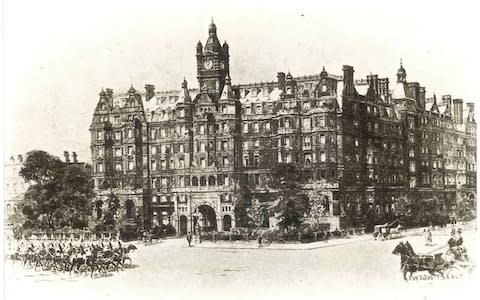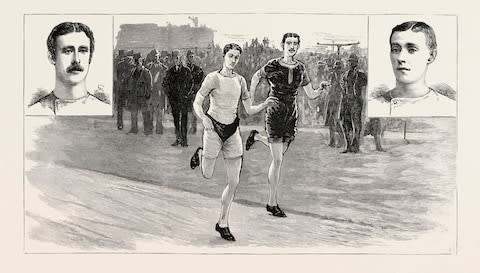In search of London's lost velodromes

Britain has become world-renowned for cycling fast in circles. Thanks to a surge in investment, much of it coming from UK Sport, we're now blessed with world class facilities – multi-million pound medal factories that churn out world beating cyclists. But as well as hosting international athletes, these velodromes are open to anybody. Year round, they play host to track leagues and taster sessions; the cycling equivalent of playing 5-a-side at Wembley.
It wasn't always thus. Many of today’s champions will have started on a velodrome of different sorts – outdoors, most likely tarmacked circuits that were bigger than our indoor versions and therefore less steep, but just as fun to ride. The remnants of these outdoor tracks are still dotted around the country – many a hangover from Victorian Britain and the track cycling heyday of the late 19th Century, when there were 26 velodromes in London alone.
In his book Ride! Ride! Ride!, Mark Welling writes that press reports at the time record “a plethora of temporary and permanent circuits on surfaces ranging from grass and cinders through to wood and cement. Fulham, Chiswick, Crystal Palace, Surbiton, Alexandra Palace, Kennington, Wood Green, Paddington, Kensal Rise, Balham, Bow Grounds, Stamford Bridge and Sheen all held regular race meetings.”
Ahead of the World Cycling Revival this June, here's a look at some of London’s lost velodromes, and the one that nearly got away.
Stamford Bridge, London
Today, few fans flocking to Stamford Bridge, home of Chelsea Football Club, will know that the stadium once hosted an array of other sports, including athletics, cricket, baseball and cycling.
Stamford Bridge opened in 1877 as a home for the London Athletic Club; it wasn't until 1905 that the football club moved in, having been founded by the building's owner Gus Mears. Aerial shots by Sir Norman Lockyer – who is also credited with discovering helium – taken from his hot air balloon in 1909 show a track around the football pitch. Archive photographs taken later in 1930 show four riders preparing for a race at the stadium.

Putney
London cyclists might be surprised to hear that Putney once had a velodrome – in fact, it was the first concrete cycling track in England. In 1888, Mr John Davis, a local builder, acquired the lease on land in West Putney and in 1891 Putney Velodrome was opened for competition.
It had a fairly short life as a velodrome and athletics track, closing at the end of the summer in 1905. It was in the area now between Hotham Road and Landford Road, a much desired area of Putney where Victorian terraces won’t leave you with much change from £1.5 million.
Balham
Hyde Farm Athletic Grounds was positioning itself as the premier track in the area during a London cycling boom. In the early 1890s, the grounds hosted football, rugby, cricket, lacrosse and most unusually baseball, which was undergoing a rise in popularity in London at the time. The famous South London Harriers, still going strong today, used the grounds for athletics meets.
But by 1896, the venue had closed. After a flurry of openings, the number of tracks hit saturation point; and at the same momeny, Britain’s newfound obsession with the motor car came along, diverting upper- and middle-class audiences (and associated sponsorship) elsewhere.
After the venue was demolished and sold at auction, Hyde Farm Estate was built and completed in 1904 on the land around what is now known as Hydethorpe Road, wedged between Clapham South and Streatham Hill stations, near Tooting Bec Common.
Catford
Catford CC is a club steeped in history with its hill climb, first raced in 1887, said to be the oldest continuing cycle race in the world. Track races, organised by Catford CC, were first held at Paddington Recreation Ground in 1889; a few years later in 1892, the London Daily News reported that they were getting around 7,000 spectators at the races. In 1894, Catford secured funding for its own velodrome.
The circuit was completed the next year; it was the first with banking in London, and had a 1000-seater grandstand (plus many more standing). Catford's track was the largest in Europe at the time – but after a promising start, spectator numbers declined alarmingly, and it was sold to a speculative builder just five years later. The velodrome ceased to be soon after – although the grandstand remained, and was used for warehousing until the 1990s.
Today, all that remains of Catford’s track cycling past is ‘Sportsbank Street’, a street name accompanying some modern housing that's built where the grandstand once was.
Paddington Recreation Ground
A cinder cycle track was built here in 1888, and replaced in 1900 by a banked track with an additional running track inside it. Paddington's track lasted longer than most of the others listed in this article; until 1987. The area that housed the cycle and athletics tracks is now a cricket pitch, and the only real sign of the past history is the grass bank parallel to Grantully Road.
Many sporting greats trained and raced on the facility. Reg Harris raced here, as did Gary Wiggins; his son Bradley is said to have taken his first tentative pedal strokes on the paths of the recreation ground. A blue plaque celebrates this; next to one unveiled by Roger Bannister to commemorate the fact he used to use the athletics track to train in the 1950s, while a medical student at nearby St Mary’s.

White City
White City stadium, known then as The Great Stadium, was built in 1907 ahead of the 1908 London Olympic games. Its design is often referenced as the precursor to the modern stadium design we are used to today. With an original seating capacity of 63,000, it hosted an array of Olympic sports, all within one venue.
The stadium had a three-laps-to-the-mile (536m) running track, a 660 yard (600m) velodrome, and also housed archery and gymnastics competition. A 100-yard swimming pool was even dug infield. Nowadays, of course, there are many separate arenas for each sport.
The stadium fell into disuse after the Olympic Games but was taken over in 1927 by the Greyhound Racing Association. It was also the centre of British Athletics from 1932 to 1971, before Crystal Palace took over. The last event ever held in the stadium was a greyhound race in September 1984.
The stadium was demolished in 1985 and the site is now the area occupied by BBC White City.
Wood Green
The Wood Green Cycle Track opened in 1895 as part of the North London Cycling and Athletics Grounds, located south of Bounds Green Road in the area now covered by Northcott Avenue. An archive photo from 1896 shows a large grandstand (capable of seating around 1,500, and accommodating 15,000 further around the track) at the start of a 24 hour race.
Other noted ‘innovative’ events held at the track included a "Daisy Race" contested on tandems by mixed men and women teams, Cyclist vs Runner races, and at Easter 1896 Britain's first outdoor ladies race (Britain vs France).
Sadly, as with many other tracks, the Wood Green Cycle Track's success was short lived. It made way for housing development in the early 1900s.
Landmark Hotel
Perhaps one of the most unlikely locations for an outdoor cycle track is the roof of the famous five star Landmark Hotel in Marylebone, London. The hotel, then called The Hotel Great Central, was designed in 1897 by Colonel Robert Edis, whose previous work included a ballroom for the Prince of Wales' estate. It had a large courtyard, dramatic entrance and contemporary amenities, such as the cycle track on the roof.
The hotel was originally unsuccessful. In the 1920s, with railway traffic falling because of the rise of the motor car, London's railway hotels weren’t often in fashionable areas of town and so The Great Central fell out of hotel use for over forty years. After a change of purpose as a convalescent home during the Second World War and then a military office building thereafter, it’s now back as a hotel - and one of the most famous in London at that. The cycle track, however, is long gone.

Lillie Bridge Grounds, West Brompton
Lillie Bridge Grounds in Fulham was a sports ground hosting many sports including athletics, boxing, cricket, cycling and football. The ground was opened in 1867 and lasted 20 years on a plot of land that now lies between West Brompton tube station and Stamford Bridge stadium.
Rather underwhelmingly, since the 1960s, it’s been used as a car park for the nearby Earl’s Court Exhibition centre. It’s one of the few sports venues of the time that didn’t give way for residential housing, although that’s set to change with the huge redevelopment of the Earl’s Court area.

According to Michael Hutchinson’s Re:Cyclists book, the venue hosted the first national championships in 1871. Its short history was impressive, hosting both the FA Cup Final in 1873 but ultimately close in 1888 after a huge riot the year previously.
According to an edition of The Spectator, “Two professionals were to run a race in the athletic grounds at Lillie Bridge on Monday; but one of the men was not fit. The bookmakers discovering this, compelled both men to withdraw; and the managers of the place seeing that, put the money received at the gate away in safety." The crowd proceeded to pull down and burn the wooden pavilion, and there were multiple reports of policemen being beaten. Things only calmed down after the police sent an extra reinforcement of constables.
Herne Hill
And finally, a mention for the London velodrome that didn’t close – but very nearly did. Herne Hill is the second oldest cycle track in the world, built in 1891 and the host of the cycling events at the 1948 Olympics. It’s the last remaining venue from the ‘48 games, and between 1987 and 2011 it was the only velodrome in London.

In 2005, for the first time that anyone could remember in its peacetime history, the velodrome was shut after negotiations on the lease reached deadlock. The track fell into disrepair, and wasn't reopened until a high profile and ultimately successful campaign from the local and cycling communities in 2011.
This year, as well as offering multiple track sessions every week for riders of all ages, Herne Hill will host the World Cycling Revival, a vintage cycling festival celebrating 200 years of the bicycle on the 14th, 15th and 16th of June 2018. The festival, run with the support of the The Herne Hill Velodrome Trust, is seen as being integral to the future funding of the velodrome as a working sporting venue for the community.
Tickets are available from £39 at www.cyclingrevival.com.


